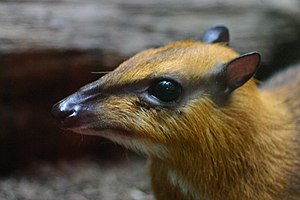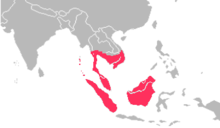Großkantschil
| Großkantschil | ||||||||||||
|---|---|---|---|---|---|---|---|---|---|---|---|---|

Großkantschil |
||||||||||||
| Systematics | ||||||||||||
|
||||||||||||
| Scientific name | ||||||||||||
| Tragulus napu | ||||||||||||
| ( F. Cuvier , 1822) |
The greater mouse-deer ( Tragulus Napu ) is a mammal of the family of mouse deer (Tragulidae).
description
Large-edged schiles are larger than small-edged schiles , but they are among the smallest cloven-hoofed animals . They reach a head trunk length of 70 to 75 centimeters, a shoulder height of 30 to 35 centimeters and a weight of 5 to 8 kilograms. Their fur is colored orange-brown on the upper side, the belly and the chin are white. They often have a brown and white pattern on the throat. Her body is rounded and sloping towards the back, while her legs are relatively thin. The pointed head is characterized by the large eyes and the black, hairless nose. Like all deer piglets, they have no antlers and no horns, but the upper canines, especially in males, are enlarged like tusks and protrude from the mouth.
distribution and habitat
Greater Kantschile live in southern Southeast Asia , from southern Thailand and southern Vietnam to the tip of the Malay Peninsula, as well as on Sumatra , Borneo and other small islands. Their habitat is predominantly forests overgrown with dense undergrowth, they are mostly to be found near the water.
Way of life
Large angels are very shy, withdrawn animals and only active at night. In order to be able to move forward faster in the thicket, they create tunnel-like trails. Outside of the mating season, they live solitary.
They are distinctly territorial animals that mark their territory with urine, feces or the secretion of a scent gland on the lower jaw. While the females usually stayed in their territory their entire life, the males move around more and are rarely in the same territory for more than a year.
food
Large angels are predominantly herbivores that eat grass, leaves and fallen fruit. On a small scale, they also consume animal foods such as insects.
Reproduction
The females are pregnant for almost their entire adult life, as they mate again just a few hours after birth. The gestation period is around 152 to 155 days and the litter size is one (rarely two). The young are fleeing nests and can walk shortly after birth. They are weaned at two to three months and sexually mature at four to five months. The maximum age of an animal in captivity was 16 years.
Großkantschile and people
In Southeast Asian fairy tales , Kantschile are considered to be cunning animals with similar characteristics to the red fox in Central Europe . In many places the meat of these animals is eaten, they are also considered easy to tame and are sometimes made into pets. The main threat, however, is the ongoing clearing of the forests. The IUCN lists the species as not endangered.
literature
- Ronald M. Nowak: Walker's Mammals of the World. Johns Hopkins University Press, 1999, ISBN 0801857899 .
Web links
- Photos, distribution map and additional information
- Tragulus napu inthe IUCN 2013 Red List of Threatened Species . Posted by: Timmins, RJ, Duckworth, JW, Steinmetz, R. & Pattanavibool, A., 2008. Retrieved January 22, 2014.
